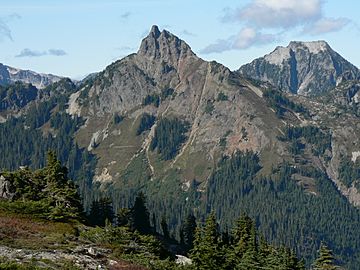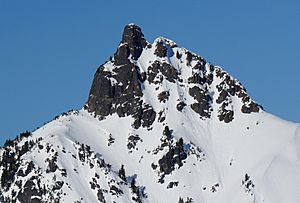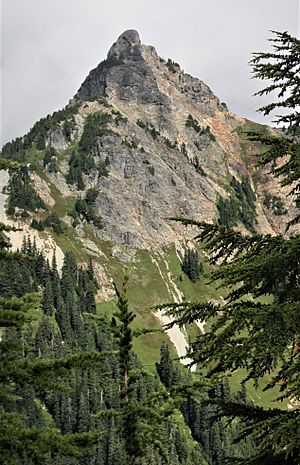Huckleberry Mountain (Washington) facts for kids
Quick facts for kids Huckleberry Mountain |
|
|---|---|

Huckleberry Mountain centered
(Burnt Boot Peak to right) |
|
| Highest point | |
| Elevation | 6,320 ft (1,930 m) |
| Prominence | 720 ft (220 m) |
| Isolation | 1.08 mi (1.74 km) |
| Parent peak | Chikamin Peak (7,000+ ft) |
| Geography | |
| Location | Alpine Lakes Wilderness King / Kittitas counties Washington state, U.S. |
| Parent range | Cascade Range |
| Topo map | USGS Chikamin Peak |
| Type of rock | Andesite |
| Climbing | |
| First ascent | May 1915 by Charles Hazelhurst and Thomas Acheson |
| Easiest route | class 4 scrambling |
Huckleberry Mountain is a 6,320-foot tall mountain in Washington state. It sits on the border between King County and Kittitas County. This mountain is found in the beautiful Alpine Lakes Wilderness, which is part of the Cascade Range.
Huckleberry Mountain is located on land looked after by the Mount Baker-Snoqualmie National Forest. It is northeast of Snoqualmie Pass and not far from Chikamin Peak, which is a taller mountain nearby. The famous Pacific Crest Trail goes along its south and east sides. From this trail, you can scramble (a mix of hiking and climbing) to the very top.
Water from the east side of the mountain flows into the Yakima River. Water from the west side flows into the Snoqualmie River.
Mountain Weather and Climate
Huckleberry Mountain is in a "marine west coast" climate zone. This means it gets a lot of moisture from the Pacific Ocean. Most weather systems start over the Pacific Ocean and move towards the Cascade Mountains.
When these weather systems hit the tall Cascade Mountains, they are forced to rise. As the air rises, it cools down and drops its moisture. This causes a lot of rain or snow to fall on the mountains. This process is called orographic lift.
Because of this, the west side of the Cascades gets a lot of rain and snow, especially in winter. Winters are usually cloudy. However, in summer, high-pressure systems over the Pacific Ocean often bring clear skies. The best time to visit or climb Huckleberry Mountain is usually from July through September.
How Huckleberry Mountain Formed
The Alpine Lakes Wilderness has very rugged land. You can see sharp peaks, deep valleys carved by glaciers, and granite rock walls. There are also more than 700 mountain lakes!
The varied land and big changes in height across the Cascade Range happened over millions of years. These changes also led to different climates and types of plants in the area. The land here ranges from about 1,000 feet high to over 9,000 feet on Mount Stuart.
The Cascade Mountains began to form millions of years ago. This was during a time called the late Eocene Epoch. The North American Plate (a huge piece of Earth's crust) was moving over the Pacific Plate. This caused a lot of volcanic activity. Also, smaller pieces of land called terranes helped create the North Cascades about 50 million years ago.
About two million years ago, during the Pleistocene period, huge sheets of ice called glaciers moved across the land. They carved out the landscape and left behind rocks and debris. The last glaciers in the Alpine Lakes area started to melt and move away about 14,000 years ago. They were gone from the area by 10,000 years ago. The "U"-shaped valleys you see today were formed by these glaciers.
The lifting of the land (called uplift) and cracks in the Earth's crust (called faulting) worked with the glaciers. Together, these forces created the tall peaks and deep valleys of the Alpine Lakes Wilderness.





